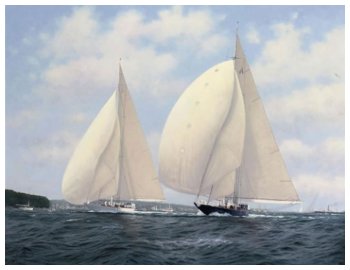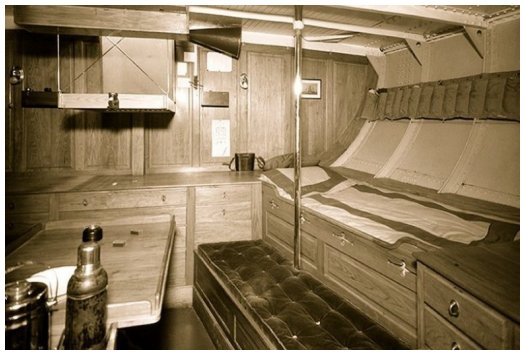CONDITIONS TO GOUVERN THE MATCH
Yves GARY Hits: 4121
Category: 1934 : CHALLENGE N°15
 Negotiations with the Royal Yacht Squadron for holding the races for the America’s Cup having been completed, the conditions to govern the match were announced yesterday by the New York Yacht Club.
Negotiations with the Royal Yacht Squadron for holding the races for the America’s Cup having been completed, the conditions to govern the match were announced yesterday by the New York Yacht Club.
The contests again will be held in Block Island Sound off Newport, R. I., where the late Sir Thomas Lipton made his last try for the old trophy in 1930.
The first race will be sailed on Sept. 15 and the winning of four contests again will decide the issue. Outstanding in the conditions is a concession on the part of the New York Yacht Club, the defending organization, that the challenging yacht Endeavour, being built by Charles E. Nicholson for T. O. M. Sopwith, the English airplane constructor who has succeeded the world-famed tea merchant in the quest for the cup, may not have to race.
The Royal Yacht Squadron, which sent the challenge on Oct. 13 last on behalf of Mr. Sopwith and the racer being built for him, may substitute another yacht upon notice sixty days before the first race. She must be of the stipulated cup size, however, and comply with the conditions as to hull and rig.
 Suggested by Committee.
Suggested by Committee.
This is an entirely new arrangement, and George A. Cormack, secretary of the New York Yacht Club and of its cup committee, who announced the conditions, said it was not the result of a request on the part of the Royal Yacht Squadron, but a suggestion on the part of the cup committee in its desire to create conditions as nearly equal as possible for both challenger and defender.
In short, if the Endeavour should be beaten by W. L. Stephenson's Velsheda, which was built last Winter, the Velsheda might be substituted for her. The same would apply in case the Endeavour should be so damaged in a storm or by other cause that she could not be repaired in time for the match.
The cup committee is composed of Vice Commodore W. A. W. Stewart, chairman; Commodore Junius S. Morgan, Rear Commodore E. Townsend Irvin, Cornelius Vanderbilt, George F. Baker, Van S. Merle-Smith and Mr. Cormack.
Correspondence on behalf of the Royal Yacht Squadron was carried on by Captain F. W. Walshe, R. N., its secretary.
The defender must be named one week before the first race, as in the past. The races will be boat-for-boat ones, without time allowance, as the last ones were.
 Will Start on a Saturday.
Will Start on a Saturday.
In the challenge it was suggested that the date of the first race be about Sept. 12. That was made three days later to start the match on a Saturday. The contests will be held on succeeding weekdays, unless the contestants request an intervening day of rest.
Newport, with the starting and finishing buoy nine miles southeast of Brenton Reef Lightship, proved a much better course in 1930 than the old one off Sandy Hook, which apparently has gone into oblivion as far as another America's Cup match is concerned. There is less commercial traffic in Block Island Sound, there are fewer tide tricks, the breezes are better and there is a safer haven with cleaner water than in Sandy Hook Bay.
Again the races will be alternating ones, the first being to windward and leeward, and the second around an equilateral triangle, each of them to be thirty miles in all. Windward starts will be made in the triangular races, if possible to be arranged by the race committee, which will be composed of Edmund Lang, Robert N. Bavier and E. Vail Stebbins.
The warning signal, ten minutes before the start, will be given at 10:30 A. M. each day, if the weather will permit, and no race will be started after 12:30 P. M.
The winning yacht must complete the thirty miles in five and one-half hours, or the race must be resailed. That is to do away with one or the other contestants winning an out-and-out drifting match in but a zephyr of breeze. Should a. race result in a dead heat, as did one of those between Resolute and Shamrock IV off Sandy Hook in 1920, it must be sailed over.
 Rules for Construction.
Rules for Construction.
Rules for the construction of the racers. including their rigs, are those agreed upon by the Yacht Racing Association of Great Britain and the New York Yacht Club after the last international match. They include the requirements of Lloyd's.
One of them was the addition of cabin fittings, or living quarters in the racers, instead of making them but empty shells. In the conditions agreed upon is the requirement that these include wood flooring, partitions, doors, bedding, plumbing, water tanks, an icebox and furnishings including upholstery. The designers had estimated that with the use of light wood and aluminum the cabin fittings could be held within a total weight of five tons. Under the agreement, if it is appreciably less than seven tons, a difference in weight must be carried approximately 4 feet 6 inches below the deck. It cannot be carried down in the keel to increase a yacht’s stability.
Should one of the yachts meet with a serious accident before the preparatory signal for a race, five minutes before the start, or during a race, she will have up to four weeks in which to make repairs, but no race may be sailed after Oct. 31.
If either yacht becomes disabled during a race, through a defect in her hull, sails, rigging or gear, or through her handling, the other yacht shall continue in the race.
That agreement was inserted because of the mishap to Shamrock V four years ago. Her mainsail halyard, or hoisting cable, tore out forty-four minutes after the start of the third race. Her big sail sagged and she dropped out of that one contest.
Harold S. Vanderbilt sailed the defender Enterprise on to victory, as he was supposed to do, the rigging strength of a yacht being one of her tests. The situation caused some comment and both clubs this time agreed on inserting a clear clause to cover any repetition of it.
